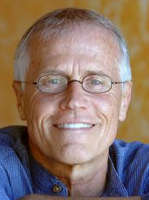
Image by Gerd Altmann
We are beginning a mythic period of existence, rather like the age portrayed in the Bhagavad Gita or in other ancient tales of darkness and light. We live at a time where every living system on earth is in decline, and the rate of decline is accelerating as our economy grows.
The very practices that bring us the goods and services we desire are destroying the earth. Given current corporate practices, not one wildlife reserve, wilderness, or indigenous culture will survive the global market economy. We are losing our forests, fisheries, coral reefs, topsoil, water, biodiversity, and climatic stability. The land, sea, and air have been functionally transformed from life-supporting systems into repositories for waste.
The Momentum of Loss
To feel the momentum of loss is to want to close one's eyes. Yet, to close one's eyes is to do the very thing that will bring forth the fruits of ignorance. I believe in rain, in odd miracles, in the intelligence that allows terns and swallows to find their way across the earth. And I believe we are capable of creating a remarkable future for humankind. As much as people are causing damage, each person contains within them the basis for hope. None of us individually wants what we are doing collectively.
Worldwide, more than one hundred thousand non-governmental organizations, foundations, and citizens' groups are addressing the issue of social and ecological sustainability in the most complete sense of the word. Together they address a broad array of issues, including environmental justice, ecological literacy, public policy, conservation, women's rights and health, population, renewable energy, corporate reform, labor rights, climate change, trade rules, ethical investing, ecological tax reform, water, and much more. These groups follow Gandhi's imperatives: Some resist, while others create new structures, patterns, and means. The groups tend to be local, marginal, poorly funded, and overworked.
It is hard for most groups not to feel palpable anxiety -- that they could perish in a twinkling. At the same time, a deeper pattern is emerging that is extraordinary.
The Momentum of A Unified Vision and Worldview
If you ask each of these groups for their principles, frameworks, conventions, models, or declarations, you will find they do not conflict. This has never happened before in history.
In the past, movements that became powerful started with a unified or centralized set of ideas (Marxism, Christianity, Freud) and disseminated them, creating power struggles over time as the core mental model or dogma was changed, diluted, or revised. The sustainability movement did not start this way. It does not agree on everything, nor should it ever, but remarkably it shares a basic set of fundamental understandings about the earth, how it functions, and the necessity of fairness and equity for all people in partaking of the earth's life-giving systems.
These groups believe that self-sufficiency is a human right; they imagine a world where the means to kill people is not a business but a crime, where families do not starve, where fathers can work, where children are never sold, where women cannot be impoverished because they choose to be mothers.
They believe that water and air belong to us all, not to the rich. They believe seeds and life itself cannot be owned or patented by corporations. They believe that nature is the basis of true prosperity and must be honored.
This shared understanding is arising spontaneously, from different economic sectors, cultures, regions, and cohorts. And it is absolutely growing and spreading, with no exception, worldwide. No one started this worldview, no one is in charge of it, no orthodoxy is restraining it. As external conditions continue to change and worsen socially, environmentally, and politically, organizations working toward sustainability increase, deepen, and multiply.
There is a difference between blind and heady optimism, and the deep conviction that no force can counter the truths we share and hold so deeply. This is the work of peace, and it is rapidly becoming the work of the world.
Reprinted with permission of the publisher,
New World Library, Novato, CA 94949. ©2000, 2002.
www.newworldlibrary.com
Article Source
Architects of Peace: Visions of Hope in Words and Images
by Michael Collopy.
 More than 350 black-and-white photographic images accompany this timely celebration of the power of nonviolence.
More than 350 black-and-white photographic images accompany this timely celebration of the power of nonviolence.
Seventy-five of the world’s greatest peacemakers — spiritual leaders, politicians, scientists, artists, and activists — testify to humanity’s diversity and its potential. Featuring 16 Nobel Peace Prize laureates and such visionaries as Nelson Mandela, Cesar Chavez, Mother Teresa, Dr. C. Everett Koop, Thich Nhat Hanh, Elie Wiesel, Archbishop Desmond Tutu, Coretta Scott King, Robert Redford, and more, the book profiles figures often working at the very nucleus of bitter conflicts.
The above excerpt by Paul Hawken is reprinted from the book.
Info/Order this book (hardcover edition)
About The Author
 Paul Hawken is an entrepreneur and sustainability advocate who founded several companies, including Smith & Hawken, the retail & catalog gardening company. Among his books are the best-selling Growing a Business, which accompanied a seventeen-part PBS series: The Ecology of Commerce, which shows the potential of business and markets to aid the environment; and most recently Natural Capitalism, with Amory Lovins and L. Hunter Lovins. He has served as cochair of the Natural Step, which sets environmental standards for businesses, and currently works as a consultant on sustainability with corporations, governments, and institutions.
Paul Hawken is an entrepreneur and sustainability advocate who founded several companies, including Smith & Hawken, the retail & catalog gardening company. Among his books are the best-selling Growing a Business, which accompanied a seventeen-part PBS series: The Ecology of Commerce, which shows the potential of business and markets to aid the environment; and most recently Natural Capitalism, with Amory Lovins and L. Hunter Lovins. He has served as cochair of the Natural Step, which sets environmental standards for businesses, and currently works as a consultant on sustainability with corporations, governments, and institutions.
Visit the author's websites at www.naturalstep.org & www.naturalcapitalism.org.
























